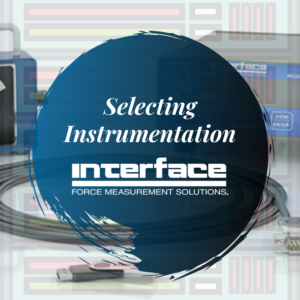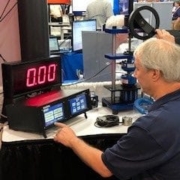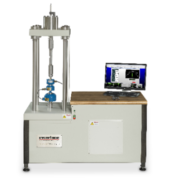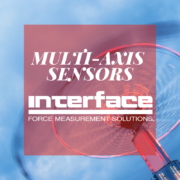Instrumentation Options in Test and Measurement
 Force and torque measurement technologies such as load cells and torque transducers are a single part of an overall system often used for test and measurement projects and programs. Instrumentation is also a key component of force and torque measurement systems. Instrumentation tools are functional for visualizing and logging the sensor data.
Force and torque measurement technologies such as load cells and torque transducers are a single part of an overall system often used for test and measurement projects and programs. Instrumentation is also a key component of force and torque measurement systems. Instrumentation tools are functional for visualizing and logging the sensor data.
When considering all the options for your project, product designers and engineers need to evaluate the type of instrumentation required to read and gather the sensor output and display the results.
Common questions to ask in preparing your test and measurement project, building a system or setting up a lab:
- Where are you going to connect your sensor technology and how?
- Do you need to store your data?
- Do you prefer an analog or digital output device?
- Are you going to plug-in your instrumentation or use hand-held, wireless or Bluetooth connectivity?
- How will your data output be displayed?
- How many channels do you need for your project or program?
 These are all questions related to instrumentation devices and how they interact with and connect to your test and measurement products. Because of the wide variety of instrumentation options, from transmitters and indicators to data logging, it is critical to carefully review the features, specifications, capacities for each. Engineers and testers should review capabilities for data collection of a device, connectors and adapter requirements, and how the device works with specific types of load cells, torque transducers, multi-axis sensors, and other testing equipment.
These are all questions related to instrumentation devices and how they interact with and connect to your test and measurement products. Because of the wide variety of instrumentation options, from transmitters and indicators to data logging, it is critical to carefully review the features, specifications, capacities for each. Engineers and testers should review capabilities for data collection of a device, connectors and adapter requirements, and how the device works with specific types of load cells, torque transducers, multi-axis sensors, and other testing equipment.
A valuable tip is to spend time reviewing the specifications of any instrumentation device you are considering, as well as speak with an experienced application engineer. The critical model and design details are provided in the product datasheet to help in your selection.
Key areas to consider in your review and design of a force and torque measurement systems include:
- Excitation
- Outputs
- Performance standards
- Environmental performance
- Power
- Mechanical definitions
- Connections
- Protocols
 There are dozens of instrumentation options available through Interface including signal conditioners, output modules, high-speed data loggers, portable load cell indicators, weight indicators, and junction boxes. Here are some of our latest additions and most popular instrumentation products:
There are dozens of instrumentation options available through Interface including signal conditioners, output modules, high-speed data loggers, portable load cell indicators, weight indicators, and junction boxes. Here are some of our latest additions and most popular instrumentation products:
- 9894 Analog Inputs Process Meter
- 4 Channel 9840-400-1-T Intelligent Indicator
- DIG-USB-F Fast USB Output Module
- 9890 Strain Gage, Load Cell and mV/V Indicator
- 9320 Battery Powered Portable Load Cell Indicator
- SGA Versatile AC/DC Powered Signal Conditioner
- INF-USB3 Universal Serial Bus Single Channel PC Interface Module
- INF4-Ethernet IP Weight Transmitter and Indicator
Download our Instrumentation Brochure
Download our NEW Digital Instrumentation Brochure
Terms and Definitions
To help get you started on the process of selecting the right instrumentation for your project, we have compiled a list of common terms used for instrumentation and in force measurement and sensor technology product descriptions.
- Accuracy: The closeness of an indication or reading of a measurement device to the actual value of the quantity being measured. Usually expressed as ± percent of full-scale output or reading.
- Adapter: A mechanism or device for attaching non-mating parts.
- Amplifier: A device that draws power from a source other than the input signal and which produces as an output an enlarged reproduction of the essential features of its input.
- Analog Output: A voltage or current signal that is a continuous function of the measured parameter.
- Analog-to-Digital Converter (A/D or ADC): A device or circuit that outputs a binary number corresponding to an analog signal level at the input.
- Bluetooth: A standard for the short-range wireless interconnection of mobile phones, computers, and other electronic devices.
- Bus Formats: A bus is a common pathway through which information flows from one computer component to another. The common expansion bus types include, Industry Standard Architecture (ISA), Extended Industry Standard Architecture (EISA), Micro Channel Architecture (MCA), Video Electronics Standards Association (VESA), Peripheral Component Interconnect (PCI), PCI Express (PCI-X), Personal Computer Memory Card Industry Association, (PCMIA), Accelerated Graphics Port (AGP), Small Computer Systems Interface (SCSI).
- Calibration: Process of adjusting an instrument or compiling a deviation chart so that its reading can be correlated to the actual value being measured.
- Communication: Transmission and reception of data among data processing equipment and related peripherals.
- Controller: Controllers deliver measurement and control functions that may be used in a wide variety of applications. They feature compact form and versatility in systems that require precise measurement of weight or force combined with processing and storage.
- Digital Output: An output signal which represents the size of an input in the form of a series of discrete quantities.
- Environmental Conditions: All conditions in which a transducer may be exposed during shipping, storage, handling, and operation.
- Frequency: The number of cycles over a specified time period over which an event occurs. The reciprocal is called the period.
- Indicator: Load cell indicators are often needed where the force, load or weight measurement needs to be displayed to a user visually and displaying the results on a PC is not feasible.
- Intelligent Indicator: Intelligent Indicators ensure sensor equipment is used for the correct amount of time, thereby helping to safeguard against mistakes or purposeful misuse.
- Output: The electrical signal which is produced by an applied input to the transducer.
- Protocol: A formal definition that describes how data is to be exchanged.
- Range: Those values over which a transducer is intended to measure, specified by its upper and lower limits.
- Signal Conditioner: A circuit module which offsets, attenuates, amplifies, linearizes and/or filters the signal for input to the A/D converter. The typical output signal conditioner is +2 V dc.
- Strain Gage: A measuring element for converting force, pressure, or tension into an electrical signal.
- Transducer Electronic Data Sheet (TEDS): Provides a force or torque transducer with electronic identification, allows sensor instrument to be “Plug & Play Ready” meets IEEE 1451.4
- Wireless: Broadcasting, computer networking, or other communication using radio signals, microwaves, and other signals.
If you still have questions about load cells, torque transducers, and the instrumentation options please give us a call at 480-948-5555 or visit www.interfaceforce.com.
For some of the key terms, we used an online reference you can find here: Source









